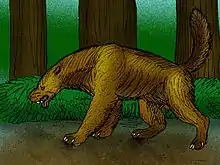Ekorus ekakeran
Ekorus ekakeran is a large extinct mustelid that inhabited late Miocene Kenya.[1]
| Ekorus | |
|---|---|
 | |
| Ekorus ekakeran | |
| Scientific classification | |
| Kingdom: | Animalia |
| Phylum: | Chordata |
| Class: | Mammalia |
| Order: | Carnivora |
| Family: | Mustelidae |
| Genus: | †Ekorus Werdelin, 2003 |
| Species: | †E. ekakeran |
| Binomial name | |
| †Ekorus ekakeran Werdelin, 2003 | |
Standing 60 centimetres (2 ft) tall at the shoulders, its build was not similar to that of modern mustelids. Modern-day weasels have short legs and can only achieve short bursts of speed. The legs of Ekorus are built like those of leopards.[2] It appears that before Africa's big cats ruled the savannas, the giant mustelid Ekorus chased down its prey, such as the three-toed horse Eurygnathohippus and the large pig Nyanzachoerus. The reason for this evolution may be related to the Great Rift Valley. Before the rift opened, Kenya was more forested.[3] Eventually as moisture was drawn from the forests by the highlands, the forests opened up into grasslands. The swifter creatures built for open terrain prospered, while the slower forest species perished.
Fossils of large Miocene mustelids have also been discovered in North America,[4] Europe,[5] and Asia,[6] as well as other parts of Africa.[7]
References
- Howell F. C. & García N. 2007. — Carnivora (Mammalia) from Lemudong’o (late Miocene: Narok District, Kenya). Kirtlandia 56: 121-139.
- Werdelin L. 2003. — Mio-Pliocene Carnivora from Lothagam, Kenya, in Leakey M. G. & Harris J. D. (eds), Lothagam: Dawn of Humanity in Eastern Africa. Columbia University Press, New York: 261-328.
- Werdelin L. & Simpson S. W. 2009. — The last amphicyonid (Mammalia, Carnivora) in Africa. Geodiversitas 31 (4) : 775-787.
- Berta, A.; Morgan, G.S. (1985). "A new sea otter (Carnivora: Mustelidae) from the Late Miocene and Early Pliocene (Hemphillian) of North America". Journal of Paleontology. 59 (4): 809–819. JSTOR 1304931.
- Willemsen, G.F. (1992). "A revision of the Pliocene and Quaternary Lutrinae from Europe". Geologica Scripta. 101 (1): 1–115. Retrieved 21 June 2020.
- Pickford, M. (2007). "Revision de los mamíferos bunodontos de tipo nutria del Mio-Plioceno del Subcontinente Indio". Estudios Geologicos. 63 (1): 85–127. doi:10.3989/egeol.07631192.
- Valenciano, A.; Govender, R. (June 2020). "New insights into the giant mustelids (Mammalia, Carnivora, Mustelidae) from Langebaanweg fossil site (West Coast Fossil Park, South Africa, early Pliocene)". PeerJ: 9221. Retrieved 21 June 2020.